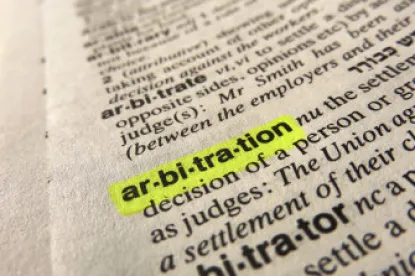A recent case raised an interesting issue regarding the relationship between English law, which suggested there was no apparent bias, and the International Bar Association Guidelines on Conflicts of Interest in International Arbitration, which suggested there was apparent bias.
In W Limited v M SDN BHD [1], Mr Justice Knowles determined that there was no apparent bias arising from the connection between a sole arbitrator’s law firm and a company within the same corporate structure as the defendant. The case raises an interesting issue regarding the relationship between English law (which suggested there was no apparent bias) and the International Bar Association Guidelines on Conflicts of Interest in International Arbitration (the IBA Guidelines) (which suggested there was apparent bias). It also reminds users of arbitration about the potential for challenges at court postaward.
Background
The claimant challenged an arbitration award pursuant to section 68(2) of the Arbitration Act 1996, alleging serious irregularity on the basis of apparent bias and a conflict of interest.
The sole arbitrator was a partner in a Canadian law firm. The law firm did work for a company (Q) that was bought by a parent company whose subsidiaries included the defendant. The defendant was, therefore, the sister company of a client of the law firm whose partner was the arbitrator in the matter at the relevant time.
There was no question of actual bias. The arbitrator did not know that his firm was doing work for Q and asserted that he would have disclosed that information had he known. He did no work himself for Q (although his firm did), and the firm did not advise the defendant or the common parent of Q and the defendant.
The arbitrator had performed conflict checks and provided disclosures on other (nonmaterial) issues. The conflict checks simply had not picked up this relationship. Further, he played no active part in the firm’s partnership, had not attended partnership meetings for a number of years, and considered himself a sole practitioner with access to the resources that a law firm can provide.
Was There Apparent Bias?
Mr Justice Knowles quickly determined that there was no apparent bias on the basis of the facts and the English law test for apparent bias. The question was whether “a fair minded and informed observer, having considered the facts, would conclude that there was a real possibility that the tribunal was biased”.[2]
Such an observer, considered Mr Justice Knowles, would have concluded that this was an arbitrator who did not know about the issue rather than one with doubtful credibility. The observer would not conclude that there was a real possibility of bias or lack of independence or impartiality.
IBA Guidelines—A Different Approach?
Although Mr Justice Knowles was able to reach his conclusion “without hesitation”, he noted that the real uncertainty in this case came not from the English law, but from the IBA Guidelines.
Contrary to the position under English law, the situation under consideration in the present matter fell within the IBA Guidelines’ description of a conflict, namely:
The arbitrator or his or her firm regularly advises the party, or an affiliate of the party, and the arbitrator or his or her firm derives significant financial income therefrom (emphasis added).
Mr Justice Knowles noted that, although the IBA Guidelines were not binding on the English Court, they “make a distinguished contribution in the field of international arbitration”. Further, because the arbitration under consideration was international, he did not simply want to ignore the IBA Guidelines as not representing English law and move on.
Nonetheless, he found it hard to understand why the situation described in the IBA Guidelines would necessarily produce a conflict (as the IBA Guidelines suggested) and considered that it was a situation “classically appropriate for a case-specific judgment”. He concluded that the appropriate approach was to consider the IBA Guidelines and to explain why they were not yet correct. His initial conclusion that there was no apparent bias, therefore, was not changed by the IBA Guidelines.
Comment
A key advantage of an arbitration award (at least as far as the winning party is concerned) is the limited ability to challenge it. This case makes clear that challenges on the grounds of serious irregularity and bias are difficult to maintain, even where the challenge seemed to be supported by internationally respected and accepted guidelines.
That said, even an unsuccessful challenge will slow down enforcement. Parties inevitably rely in large part on the conflict systems of law firms and barristers when solicitors and barristers are appointed as arbitrators in parties’ matters. However, the parties themselves may be better placed to advise of potential conflicts. Although it will never be possible to eliminate potential challenges entirely, a party that is able to identify potential conflicts itself may avoid enforcement difficulties further down the line.
[1] [2016] EWHC 422 (Comm).
[2] Porter v Magill [2002] AC 357.



 />i
/>i

